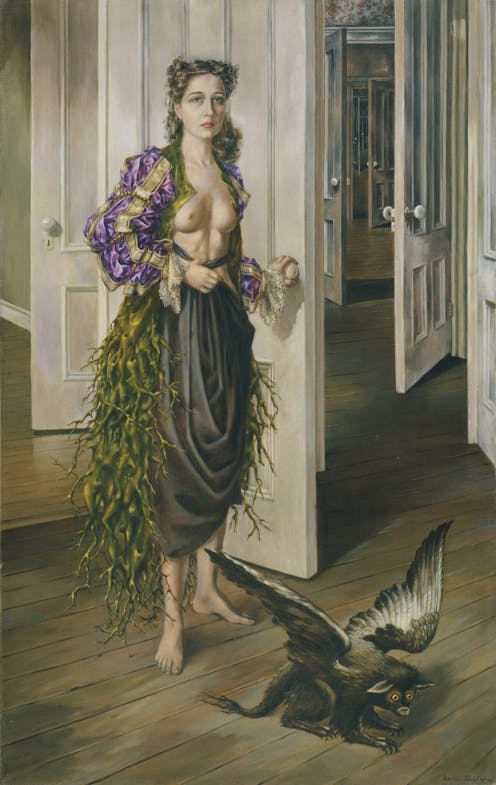How Dorothea Tanning’s ‘Birthday’ painting challenged male-dominated surrealism
- Dorothea Tanning’s “Birthday” painting (1942) marked her arrival into the surrealist movement, challenging male-dominated art and literature.
- The painting features a dreamlike scene with an endless series of doorways, which can be interpreted as representing infinite ways out or domestic entrapment, leaving room for multiple interpretations.
- “Birthday” showcases Tanning’s insistence on agency, placing herself at the center of the composition and confronting the viewer with her steady, unseductive gaze, a departure from the typical female muse or dream figure in surrealist art.
- The painting reflects Tanning’s innovations within surrealism, including dream logic, metamorphosis, and psychic ambiguity, which invite multiple interpretations and exude complexity of the subconscious.

When American artist Dorothea Tanning painted “Birthday” in 1942, she announced her arrival – an artistic birth, as she later described it – into the surrealist movement.
Surrealism is an avant-garde art and literary movement that began in Paris in the 1920s and sought to unleash the unconscious mind. Women artists within the movement often drew on its dreamlike language to counter male surrealists’ idealized and objectifying portrayals of women, reclaiming their own agency and identity.
The movement’s centennial will be celebrated during the Philadelphia Museum of Art’s “Dreamworld: Surrealism at 100” exhibition, which opens Nov. 8, 2025, and runs through Feb. 16, 2026.
As an artist, writer and curator who focuses on feminism in art history, I’m excited to see Tanning’s “Birthday” displayed in Philadelphia alongside works by canonical male surrealists such as Salvador Dalí and Joan Miró. This juxtaposition invites viewers to reexamine surrealism through the contributions of women like Tanning, as well as Leonora Carrington and perhaps Remedios Varo.
These women brought radical innovations to the movement. Their depictions of female experiences of sexual awakening, domestic entrapment and psychic resistance added new depth to the dreamscapes envisioned by their male contemporaries.
A steady, unseductive gaze

Philadelphia Museum of Art
In “Birthday,” the artist paints herself bare-chested and wearing an elaborate skirt composed of flowing, vinelike forms that intertwine with female figures, evoking an organic world somewhere between vegetation and the sea. She stands tall in a corridor lined with doors that seem to recede endlessly. Is she trapped in domesticity, or do the doors represent infinite ways out? She stares off, seemingly at the painter, not the viewer. At her feet is a fantastical winged feline creature, its presence both companionable and uncanny.
The composition has many hallmarks of surrealism, including dream logic – the strange, flowing and often illogical progression of images reflecting the unpredictable nature of dreams – metamorphosis and psychic ambiguity. Psychic ambiguity refers to an open-ended emotional or psychological meaning. It invites multiple interpretations and exudes the complexity of the subconscious.
But what distinguishes “Birthday,” in my view, is its insistence on agency.
Many surrealist artists cast women as muses or dream figures conjured for the male gaze. Tanning, however, places herself at the center. Her steady, unseductive gaze confronts the viewer and demands recognition of her authorship.
French writer and poet André Breton’s 1924 “Manifesto of Surrealism” urged artists to liberate thought from rational constraint. Breton aimed to access the unconscious through dream and automatism, a surrealist technique of creating art without conscious control, allowing spontaneous expression from the subconscious mind, free from rational thought or aesthetic rules.
A fascinating array of doors
Beyond her self-portrait, “Birthday” depicts a seemingly unending series of doorways. Tanning wrote about taking inspiration from her New York apartment:
“I had been struck, one day, by a fascinating array of doors – hall, kitchen, bathroom, studio – crowded together, soliciting my attention with their antic planes, light, shadows, imminent openings and shuttings. From there it was an easy leap to a dream of countless doors.”
The “dream of countless doors” could represent the perpetual potential for change and renewal, or the ability to leave doors open for the imagination, or opportunities beyond domesticity for women.
Tanning refused to be confined by the label of “woman artist,” even as her work bore feminist depth. Nonetheless, her paintings modeled a form of self-determination that continues to resonate in the work of contemporary artists such as South African photographer Zanele Muholi and American mixed-media artist Mickalene Thomas.
Ultimately, “Birthday” is not just a surrealist self-portrait; it is a threshold work. It situates the artist between known and unknown, rational and subconscious, constraint and liberation. For Tanning, it marked her own artistic birth. For viewers today, it marks a reminder that self-representation is not static but always in motion, transforming.
Read more of our stories about Philadelphia and Pennsylvania, or sign up for our Philadelphia newsletter.
![]()
Sally Jane Brown does not work for, consult, own shares in or receive funding from any company or organization that would benefit from this article, and has disclosed no relevant affiliations beyond their academic appointment.
